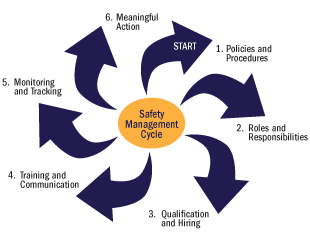
What Is the Safety Management Cycle?

How Is the Safety Management Cycle Used
The SMC provides SIs and motor carriers with a step-by-step process that goes beyond just identifying “what” the violation is to get at “why” the safety performance issue is occurring. The tool is made up of the following six Safety Management Processes (SMPs), which are laid out in a specific order to represent the areas of a motor carrier’s operations: Policies and Procedures, Roles and Responsibilities, Qualification and Hiring, Training and Communication, Monitoring and Tracking, and Meaningful Action.Taken together, the SMPs help to provide a framework for SIs and motor carriers to identify and correct breakdowns or safety compliance issues before or after they have occurred. This framework can be applied to all of the seven Behavior Analysis and Safety Improvement Categories (BASICs): Unsafe Driving, Hours-of-Service Compliance, Driver Fitness, Controlled Substances/Alcohol, Vehicle Maintenance, Hazardous Materials Compliance, and Crash Indicator.
As part of this framework, SIs and motor carriers use job aids to assist them in applying the SMC. SMC job aids are available for each of the BASICs with the exception of the Vehicle Maintenance BASIC, which has two separate job aids: Inspection-Repair-Maintenance and Cargo-Related. These job aids provide recommended safety improvement practices, which FMCSA developed with input from enforcement personnel and the motor carrier industry.



No comments:
Post a Comment